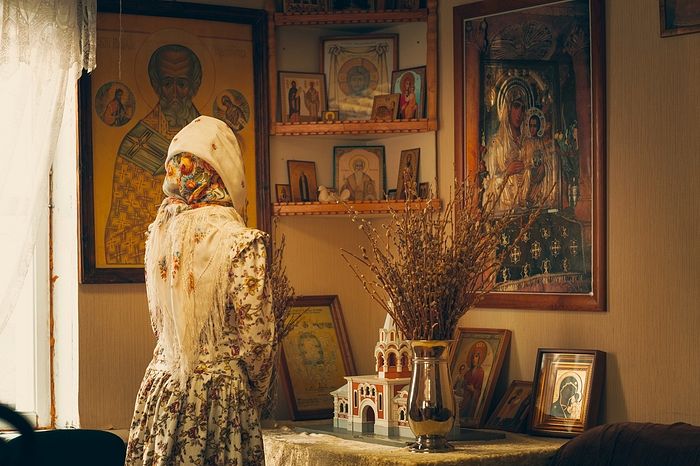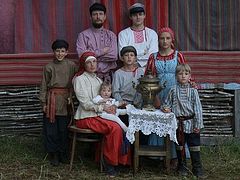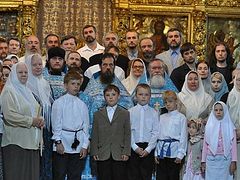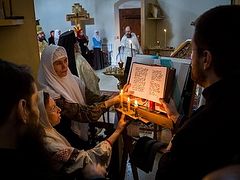Until the revolution in Russia, there was a universal tradition of reading the “lay order” of the services. In the absence of the priest in church, or at home, the entire family would read part or all of the daily cycle of Church services. We will talk today about what happened to this good tradition, how to revive it, and what benefit it brings for the whole body of the Church.
“Seven times a day do I praise Thee”
The daily cycle of Orthodox worship is divided into the following parts:
-
Vespers
-
Compline
-
Midnight Office
-
Matins
-
First Hour
-
The Hours (Third, Sixth, Ninth)
-
Typica
In ancient times, for example in Byzantium, all the parts of the Church services were celebrated separately from each other. With the spread of Christianity, especially in large cities, the services were consolidated and came down to us in the familiar form of conciliar prayer in the evening (when the liturgical cycle begins) and in the morning.
In former times, the population of the territories was less dense, and transportation lines were more difficult and long. One priest could minister to vast territories; his travels could go on for months. Parishioners left without a pastor in church had no right to quit the Church prayers and continued to celebrate the services without a priest. Naturally, the Sacraments were inaccessible for the laity, but the kliros continued to sing and read, and the priestly exclamations were substituted by special ones pronounced by the so-called “elder” from among the laity.
Rus’ received the faith from Byzantium and adopted its customs. People sought to bring their home prayer closer to church prayer, so morning and evening prayers were, as a rule, part of their daily cycle, and in special cases, the services were prayed in full by the head of the family and his household. For example, they usually prayed in the morning reading the Midnight Office, and in the evening—Compline. For this could be used only the Horologion or the Sequential Psalter. The ancient books were more universal than modern ones: They had a lot of additions needed to do the services on their own. A full collection of all Church books was not possible due to their costliness and their small print runs.
The beauty of the Church services in antiquity was treated seriously and thoroughly. Whole generations were brought up on the Church books. The lingering Znamenny chants in one voice were forever imprinted in the minds of the children and formed a rhythm of life of deliberateness and bright regularity. People sought, despite their pressing needs, to dedicate their time to prayer, to delight in the word of God, and to progress in it.
It’s no surprise that they sought to make home prayer closer to church prayer. The Russian people understood pray without ceasing (1 Thess. 5:17) not only quantitatively but also qualitatively. What’s the point of prayer if it’s done carelessly, without immersion and the creation of a special atmosphere where you can truly detach yourself from the noise of the world and hear God?
The family, the home, was a small Church, not only in a spiritual but also in a physical sense. Wealthy citizens or craftsmen-carpenters could afford to construct chapels or home churches in their yards or even in their homes. This was done not for the sake of beauty or proud competition with neighbors, but nothing other than prayer. The faithful tried to penetrate deeper into the meaning of the texts, to better understand the symbolism of the services.
Prayer began with Vespers, as evening was given the first place in the book of Genesis: And the evening and the morning (Gen. 1:5). The beginning of human history was joyous, but it was quickly darkened by the Fall.
St. John Cassian the Roman describes Compline as a service done “after evening,” or after dinner. Initially, it was a prayer “for the coming sleep” for monks. Unsurprisingly, it became its own peculiar form of evening prayers for the laity at a later time. The rite of forgiveness with a kneeling plea to God to forgive one for all the trespasses of that day has been preserved in Compline to our day.
Midnight Office recalls the imminence of the Second Coming of Christ. This service, the first to be served after sleep, became an unspoken morning prayer rule in Rus’. In Edinovertsi parish practice it’s usually read as the first service of morning worship.
The events of Matins are dedicated to the appearance of Christ in the world and His Resurrection. Today, Matins is more often served in the evening in parishes. In ancient times, it could also be prayed early in the morning, when they woke up at midnight for the Midnight Office.
The First Hour is dedicated to the remembrance of the judgment of Pilate and the high priests over the Lord, the Third to the descent of the Holy Spirit upon the apostles, the Sixth to the Crucifixion and sufferings of Christ on the Cross, and the Ninth to His death on the Cross.
Instead of Liturgy, they would usually serve Typika in the lay rank and a moleben dedicated to the feast of the day. It should be noted that in this way, the laity would serve the full cycle more often, of course, collectively in churches and chapels, in the absence of a priest. It was a rarity at home, but that didn’t rule out the possibility. In any case, Christians tried to live in a liturgical cycle, as the Church services in Rus’ were the best school of theology—hence their length, which allowed people to immerse themselves in attentive listening to the words of the sacred texts.
Today it seems nearly impossible to do the services under our home conditions. Work, family, a million cares… But we should at least try, and if we don’t pray the entire daily cycle, then at least part of it. Below we will talk about the replacement of the daily cycle with the Jesus Prayer and Psalter, and also about why a modern man needs this practice. But everything in order.
Prepare yourself
If worship is a feast, and even otherworldly, that means it requires special preparation.
The Edinovertsi have preserved a good custom of having special clothes for prayer, designed not for physical but for spiritual labor. It’s quite logical for traditional cultures, and originates in deep antiquity. However, today this tradition is also leaving our parishes, but the men still try to wear caftans and traditional folk shirts with belts, and the women wear head coverings they hold fast with breastpins and put on beautiful Russian sarafans. This is not “cosplay” or showing off, as people tend to say now, but one of the ways to psychologically adjust yourself to prayer. After all, we put on a formal suit for work, and a uniform for sports. Moreover, our external appearance helps create the necessary atmosphere during conciliar prayer. Thinking about those around us, we minimize the causes for temptation.
Of course, this is simpler in the home environment, but to have a tradition of “prayer clothes,” when possible, will be useful, including for children. It lays a building block in the formation of a sense of sanctity and that prayer is a special work.
It’s great if you can pray with candles or lampadas. If you cannot see, of course you can use electricity. Candles and lampadas are not a rule, but another way to set the mood for prayer.
And, finally, an important condition—doing the seven-bow beginning before the reading of sacred texts. It is also called the entrance and exit bows, as it precedes the services (home and church) and follows after their completion:
“God, be merciful to me, a sinner (bow from the waist).
Thou hast created me, O Lord, have mercy upon me (bow from the waist).
Countless times have I sinned, O Lord, have mercy and forgive me, a sinner (bow from the waist).
It is truly meet to bless thee, O Theotokos, ever blessed and most pure and the Mother of our God. More honorable than the Cherubim, and more glorious beyond compare than the Seraphim, without corruption thou gavest birth to God the Word. True Theotokos, thee do we magnify (prostration, always).
Glory to the Father and to the Son and to the Holy Spirit (bow from the waist).
Both now and ever and unto the ages of ages. Amen (bow from the waist).
Lord, have mercy; Lord, have mercy; Lord, bless (bow from the waist).”
And we finish with the small dismissal
“Lord Jesus Christ, Son of God, for the sake of the prayers of Thy Most Pure Mother, by the power of the Precious and Lifegiving Cross, and my holy guardian angel, and for the sake of all the saints, have mercy and save me, a sinner, for Thou art good and lovest mankind. Amen (prostration, without the Sign of the Cross).”
Are you ready yet?
The beginning is made up of universal prayers; it is often done before leaving the house for church and upon returning from it, and just before leaving the house for any reason. Sometimes it replaces morning and evening prayers when there is not enough time, or when you’re very tired. The beginning can precede and finish any matter. The famous expression “to lay a beginning” was born here. In other words, people read these obligatory prayers and thereby began their affairs with a petition to God.
Now it’s time to move on to the main part of prayer. It’s not possible to lay out here even one of the texts of the daily cycle. I will only say that they are all in the public domain and quite inexpensive in print. The evening service usually takes four hours, the morning—two, if they are read as appointed at home. Of course, Compline and Midnight Office are about thirty to forty minutes—about the same amount of time as the modern lay practice of morning and evening prayers, so it’s not difficult to take them on.
My colleagues have already written that on the days of the great Church feasts or when it’s impossible to go to the service, it can be necessary to celebrate them at home. Thereby, you as if join in the communal prayer both of your parish and of all Orthodox parishes, as, you will, in fact, be celebrating the same service.
On bows and the Psalter
We have already spoken about ways to replace the daily cycle. This used to be done by monks in sketes and laymen who didn’t have the necessary liturgical books. But in our parish practice we tried to hold conciliar prayer in the same way. In any case, for cell, family prayer, such knowledge will only be of benefit.
So, the practice of replacing the daily cycle of services with the Jesus Prayer with bows and without has very ancient roots. Laboring in isolation from civilization, monks prayed with the help of a verveets (an ancient prayer rope). By the way, this custom has survived to this day—for example, in Athonite monasteries, sometimes the monks pray certain parts of the daily cycle with the help of the Jesus Prayer, whether in their cells or together.
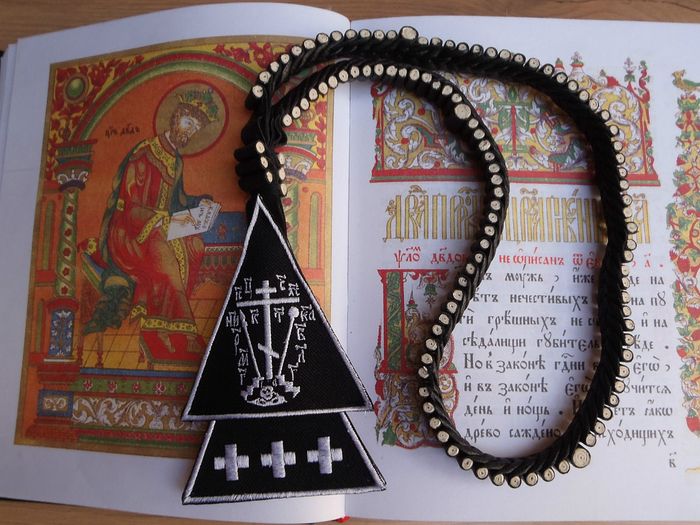 Photo: citydesert.files.wordpress.com
Photo: citydesert.files.wordpress.com
The rule of prayer on the lestovka1 without bows:
-
For Vespers: 600
-
For Great Compline: 700
-
For Small Compline: 400
-
For Midnight Office: 600
-
For Matins: 1,500
-
For the Hours: 1,000; with the Inter-Hours: 1,500
And with bows:
-
For Vespers: 300 bows
-
For Great Compline: 300 bows
-
For Small Compline: 200 bows
-
For Midnight Office: 300 bows
-
For Matins: 700 bows
-
For the First Hour: 150 bows
-
For the Third, Sixth, and Ninth Hours: 500 bows; for the Hours with the Inter-Hours: 750 bows
Before saying these prayers, it is also necessary to “lay a beginning” and to read prayers before every part of the service and after. There are instructions on how to do such a service in the Typicon for Home Prayer, common among Old Believers.
If you decide to pray the Psalms, then the guidelines are as follows:
-
For Vespers: 2 Kathismas
-
For Great Compline: 2 Kathismas
-
For Small Compline: 1 Kathisma
-
For Midnight Office: 2 Kathismas
-
For Matins: 5 Kathismas
-
For the First Hour: 1 Kathisma
-
For the Third, Sixth, and Ninth Hours: 3 Kathismas
Bows, as you know, give the body and spirit a special vigor, and if you try to do the entire cycle with the lestovka, it will take about two hours in the evening, and a little more than an hour in the morning. Praying the Psalter is closer to the amount of time needed to do the lay services from the books.
The Church without prayer is not the Church
This article does not allow one to consider in more detail all the subtleties of doing the home services, which demands special books. Fortunately, today all the information can be found online or bought in print. In general terms, I have spoken about how to pray the daily cycle and how to replace it with the Jesus Prayer and the Psalter, which is no less beneficial for the soul.
I must say that such a practice broadens one’s spiritual horizons. It has already been noted that in Rus’, the services were the best school of theology—not books or homilies (although we still had those!), but precisely the services. They included a body of texts, which, being read and sung, bring benefit to the soul, unite one with God, and open new horizons of contemplation. Independently praying the services of the Church can give an understanding of many, sometimes incredibly subtle aspects of the spiritual life that can escape the layman during the services in church.
First, you’ll be able to get closely acquainted with the services in the church. All the symbolism of the services, passing through yourself, is better revealed to you in this practice—that is, read independently. Second, the practice of lay services itself, not even at home but in a group of parishioners and even at church with the priest, teaches the laity responsibility, strengthens their ecclesiastical self-consciousness, alters their attitude to the services, and encourages more active parish work. This author’s opinion is that the practical immersion of the laity in the services, that is, the frequent practice of doing the services at home or at church, strengthens the Church.
Unfortunately, in recent times, we more and more often have to face the sad phenomenon of the degradation of prayer in church. The interpretation of the words, faith without works is dead, is striking where prayer, that is, the first work of faith, is for some reason not considered a work. The text of the prayers in church seem to be ignored, and these living words of communication with God, the word of God, addressed to the heart of man through a reader or a singer, are reduced almost to an incantation, which only has to sound forth—but what and how is not important.
Prayer is not an incantation. It is the voice of God, bringing the most important meaning of life to us amidst the noise of the sea of life, and it is our own words to the Lord—repentant, grateful, or laudatory. We pass every word of the prayers through our own hearts. This is one of the most important steps for regaining our lost connection with God; for if the Church ceases to pray, it ceases to be the Church.

